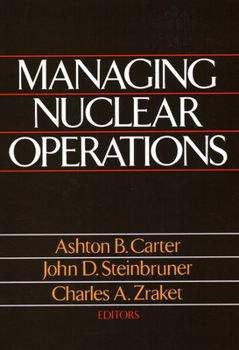Managing Nuclear Operations
Select Format
Select Condition 
Book Overview
During four decades of experience with nuclear weapons, public awareness and discussion have focused on their basic properties and capabilities--the explosive power they contain, the technical capabilities of the missiles and aircraft that carry them, the size of the Soviet and American arsenals, and the magnitude of destruction those arsenals could accomplish. Yet little attention has been paid to the technologies, procedures, and organizational arrangements used to manage and control nuclear forces. Many assert the importance of "command, control, communications, and intelligence" (C3I), but serious and detailed studies supporting that assertion are few. Managing Nuclear Operations provides a comprehensive and detailed examination of U.S. Nuclear operations and command and control. The contributors, experienced in operations and C3I., discuss peace-time safety and control of nuclear weapons worldwide, the survival under nuclear attack of the reasonable command authorities presupposed by deterrence theory, and the means for terminating nuclear war before it escalates to all-out exchanges. They describe command posts, warning sensors, communications technologies, the selection of nuclear targets, and the exercise of political authority over nuclear operations. The decisionmaking process of command and control is examined, as are the various perspectives of the decisionmakers.
Format:Paperback
Language:English
ISBN:0815713134
ISBN13:9780815713135
Release Date:February 1987
Publisher:Globe Pequot Publishing Group Inc/Bloomsbury
Length:776 Pages
Weight:0.65 lbs.
Dimensions:1.6" x 6.1" x 9.1"
Customer Reviews
1 rating
An overview of stockpile-to-target sequence
Published by Thriftbooks.com User , 25 years ago
One of the first things you notice is the weight of this tome, (1 5/8-inch spine) and the intellectual weight of contributors to the book. Household names include John Toomay, Russell Dougherty, Michael May, Paul Bracken and the editors. Flipping through the work reveals an essential list of acronyms, outstanding graphics, and thoroughly-footnoted text. The book is divided into three sections: (1) nuclear operations, (2) the command system, and; (3) policy perspectives. My primary interest was in policy, (which required reading the whole book). Highly technical subjects like communications links are rendered at a level that I had no trouble understanding. Technical descriptions are so well written that even elected officials will understand them. Common misconceptions among memebers of the public are discussed. One such misconception is that a nuclear exchange is supposed to flatten everthing in the opposing nation. An interesting, related film describing Minuteman training operations is "Missile," Zipporah Films, 1986.





